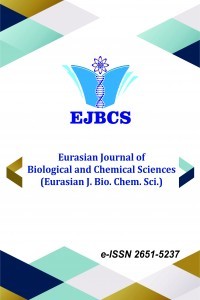Fitozom formülasyonundan berberin miktar tayini için HPLC yönteminin geliştirilmesi ve analitik validasyonu
Berberin, Fitozom, Fosfolipid kompleks, HPLC, Analitik validasyon
Development and Validation of HPLC Method for the Quantification of Berberine in Phytosome Formulations
Berberine, Phytosome, Phospholipid complex, HPLC, Analytical validation,
___
- 1. Cicero AFG, Baggioni A. 2016. Berberine and its role in chronic disease. In: Gupta S, Prasad S, Aggarwal B. (eds) Anti-inflammatory Nutraceuticals and Chronic Diseases, Advances in Experimental Medicine and Biology, vol 928. Springer, Cham
- 2. Ghanbarzadeh B, Babazadeh A, Hamishehkar H. 2016. Nano-phytosome as a potential food-grade delivery system. Food bioscience. 15:126-135.
- 3. Karataş A, Turhan F. 2015. Phyto-phospholipid complexes as drug delivery system for herbal extracts/molecules. Turkish Journal of Pharmaceutical Sciences. 12(1): 93-102.
- 4. Kidd PM. 2009. Bioavailability and activity of phytosome complexes from botanical polyphenols: the silymarin, curcumin, green tea, and grape seed extracts. Altern Med Rev. 14(3): 226-46.
- 5. Kulkarni SK, Dhir A. 2010. Berberine: a plant alkaloid with therapeutic potential for central nervous system disorders. Phytotherapy Research: An International Journal Devoted to Pharmacological and Toxicological Evaluation of Natural Product Derivatives. 24(3): 317-324.
- 6. Liang Y, Xu X, Yin M, Zhang Y, Huang L, Chen R, Ni J. 2019. Effects of berberine on blood glucose in patients with type 2 diabetes mellitus: a systematic literature review and a meta-analysis. Endocrine journal. 66(1):51-63.
- 7. Sut S, Faggian M, Baldan V, Poloniato G, Castagliuolo I, Grabnar I, Peron G. 2017. Natural deep eutectic solvents (NADES) to enhance berberine absorption: an in vivo pharmacokinetic study. Molecules. 22(11): 1921.
- 8. Wang ZC, Wang J, Chen H, Tang J, Bian AW, Liu, T, Yang F. 2020. Synthesis and anticancer activity of novel 9, 13-disubstituted berberine derivatives. Bioorganic & Medicinal Chemistry Letters. 30(2): 126821.
- 9. Yılmaz A, Genç Ö, Bektaş S. 1997 Enstrümantal Analiz Yöntemleri (ikinci baskı), Ankara: Hacettepe Üniversitesi Yayınları.
- 10. Yu F, Ao M, Zheng X, Li N, Xia J, Li Y, Chen XD. 2017. PEG–lipid–PLGA hybrid nanoparticles loaded with berberine–phospholipid complex to facilitate the oral delivery efficiency. Drug delivery. 24(1): 825-833.
- 11. Zhao Z, Wei Q, Hua W, Liu Y, Liu X, Zhu Y. 2018. Hepatoprotective effects of berberine on acetaminophen-induced hepatotoxicity in mice. Biomedicine & Pharmacotherapy. 103: 1319-1326.
- Yayın Aralığı: Yılda 2 Sayı
- Başlangıç: 2018
- Yayıncı: Muhammet DOĞAN
Merve KAVASBASIOGLU, İlhami TUZUN, Yaşar ALUÇ
Multiple shoot induction and plant regeneration of Staurogyne repens (Nees) Kuntze
Merve Şifa Hane KÖSE, Muhammet DOĞAN, Gökhan SADİ
Ayça GÜNGÖR-AK, Ayşegül KARATAŞ
Bükay YENİCE GÜRSU, Elif AKSÖZ, Büşra ASLAN, Betül YILMAZ ÖZTÜRK, İlknur DAĞ
Kedilerde Piretroid Toksikasyonu
A study on the skull of the striped hyaena (Hyaena hyaena: Hyaenidae, Carnivora)
Erol ATAY, Mahmut TATLI, İsmail ÇETİN
A Validated HPLC-UV Method for Determination of Dopamine HCl in Injectable Solutions
